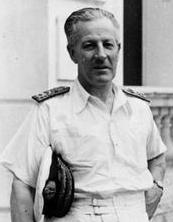Gresham Nicholson facts for kids
Quick facts for kids
Sir Gresham Nicholson
|
|
|---|---|

Nicholson in March 1945
|
|
| Born | 16 December 1892 |
| Died | 28 July 1975 (aged 82) |
| Allegiance | United Kingdom |
| Service/ |
Royal Navy |
| Years of service | 1914–1950 |
| Rank | Admiral |
| Commands held | HMNB Devonport (1945–50) Royal Naval Barracks, Chatham (1940–43) 6th Destroyer Flotilla (1938–40) HMS Somali (1938–40) HMS Curacoa (1936) HMS Pegasus (1935) |
| Battles/wars | First World War Second World War |
| Awards | Knight Commander of the Order of the British Empire Companion of the Order of the Bath Distinguished Service Order Distinguished Service Cross Mentioned in Despatches (2) Order of the Phoenix (Greece) |
Sir Randolph Stewart Gresham Nicholson (born December 16, 1892 – died July 28, 1975) was a very important officer in the Royal Navy, which is the United Kingdom's navy. He later became the Lieutenant-Governor of Jersey, a special island. He was known for his bravery and leadership during both the First World War and the Second World War.
A Life of Service
Sir Randolph Nicholson had a long and impressive career in the Royal Navy. He served his country for many years, from 1914 to 1950. He was involved in some of the biggest conflicts of the 20th century.
During the First World War, Nicholson was part of the Harwich Force. This was a group of ships that protected the coast of Britain. He also took part in the famous Zeebrugge and Ostend Raids in 1918. These were daring attacks on German naval bases.
After the war, he worked at the Royal Navy College, Dartmouth. This is where future naval officers are trained. He also served as an Aide-de-camp (a personal assistant) to the Governor of Malaya and the Straits Settlements. These were British territories in Southeast Asia.
In 1935, he became the Captain of HMS Pegasus. This was an early type of aircraft carrier, a ship that carries airplanes. The next year, in 1936, he commanded the cruiser HMS Curacoa.
World War II Contributions
As the Second World War began, Nicholson was the Captain of HMS Somali. He also commanded the Tribal Destroyer Flotilla, a group of powerful destroyer ships. Just two hours after the war started, his ship, the Somali, captured a German merchant ship called the Hannah Böge. This was the very first "prize" (captured ship) of the war at sea.
He continued to serve bravely throughout the war. From 1940 to 1943, he was in charge of the Royal Naval Barracks in Chatham. This was a major base for naval personnel. He then became the Flag Officer for Ceylon (now Sri Lanka) from 1943 to 1944. After that, he was also the Deputy Commander-in-Chief of the Eastern Fleet. This was a large group of naval ships operating in the Indian Ocean.
After the War
After the Second World War ended, Sir Randolph Nicholson continued his service. He became the Admiral-Superintendent at Devonport until he retired in 1950. This role meant he was in charge of a major naval dockyard.
After retiring from the Royal Navy, he took on another important role. He became the Lieutenant-Governor of Jersey. This position meant he represented the British monarch on the island of Jersey. It's a bit like being a governor for a special territory.
There is a special memorial to him at Holy Trinity Church, Rudgwick.

